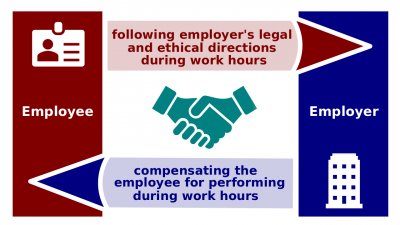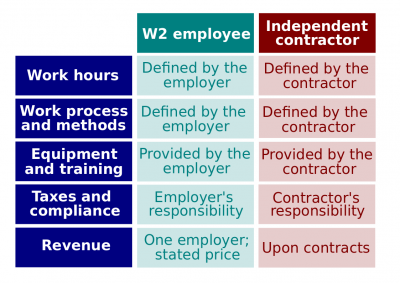Difference between revisions of "Employment Essentials"
(→Overview) |
(→Summary) |
||
| Line 38: | Line 38: | ||
===Summary=== | ===Summary=== | ||
| − | :This concludes the ''Employment Essentials'' presentation. We have taken a look at [[]]. If you haven't done yet so, you are now welcome to move to [[Nature Of Occupations]]. | + | :This concludes the ''Employment Essentials'' presentation. We have defined [[employment]] and an [[industry]], mentioned [[labor law]]s, and taken a closer look at most common [[Employment role|role]]s on the [[job market]]. Specifically, we have made stops by [[employee]]s, [[independent contractor|contractor]]s, the [[self-employed]], [[apprentice]]s, [[volunteer]]s, and [[employment candidate]]s. Differences between [[employment]] and contracting were considered in greater details. If you haven't done yet so, you are now welcome to move to [[Nature Of Occupations]]. |
==Quiz questions== | ==Quiz questions== | ||
Revision as of 17:43, 26 January 2019

Employment Essentials is the first presentation in the Introduction to Employment lecture. The lecture itself is the second in WorldOpp Orientation. Consequently, the Orientation is the first stage of WorldOpp Pipeline.
This wikipage presents its full script and those test questions that are related to that presentation.
Script
The video of the presentation is published at https://youtu.be/VncYRPGLyvQ (9:35). Here is its full text.
Overview
Welcome to Employment Essentials. In this brief presentation, we are going to take a look at employment and the job market in general. We will also make a short stop at labor law, which surely deserves the whole course, but we will have to squeeze it to the minimum for now. Let's go.
- Employment. In the workspace, employment is an agreement between an employer, who agrees to compensate an employee in exchange for his or her work time, and an employee, who agrees to follow the employer's directions during work hours in exchange for the employer's compensation, as well as a process and/or result of that exchange.
- Industry. Any part of an economy, a group of enterprises, that creates a particular type of products.
- Labor law (labour law, employment law). A set of government rules that regulate relationships between employees, employers, trade unions and the government. Government agencies usually enforce that set of laws.
- Employment role. One's role in employment relationships.
- Employee. Any individual employed by an employer for some compensation that most likely includes wages or a salary.
- Independent contractor. An individual or another legal entity that provides goods or services to another entity under terms specified in a contract or within a verbal agreement. Unlike an employee, an independent contractor does not work regularly for an employer, but works as and when required, during which time he or she may be subject to law of agency. Independent contractors are usually paid on a freelance basis. Contractors often work through a limited company or franchise, which they themselves own, or may work through an umbrella organization.
- Self-employed. The state of working for oneself as a freelance or the owner of a business rather than for an employer.
- Apprentice. Any employee who is not fully qualified to perform his or her workload, but agreed to work usually for a part of the fully-skilled worker compensation under the condition of educational assistance in order to gain the needed work-related competence.
- Volunteer. A person who does something, especially helping other people, willingly and without being forced or paid to do it.
- Employment candidate. Any candidate in a search for employment as an employee.
What employment is
Employment is basically an agreement between employer and employee. Employers agree to compensate employees for their work done and employees agree to follow employer’s directions during work hours in exchange for employer`s compensation. Employment can refer to process or result of that exchange.
When you take a look at the picture under employment overview, on the left it`s simply an employee giving an employer their performance. They follow directions during work hours. Directions should be legal and ethical. Because when a direction is not legal an employee can decline the directions given. An employer is compensating an employee for performance and this is a willful agreement. This means that both employee and employer agree on the same cause. If either the employee or employer is not happy with the other and want to cancel the contract, there should be following of a procedure on how to terminate the contract.
Employers are hiring for certain occupations and certain industries. Occupation is the regular activity that the person undertakes in order to earn his/her livelihood. For instance, a teacher or a driver or a construction worker or a manager is an occupation. An industry is any part of economy, a group of enterprises that create a particular type of products, for example car industries produces cars, computer I.T industry produces software, computer industries produces computers. Looking at employment roles, the first employment role is an employee who is any individual employed by the employer for some compensation. Most likely this includes wages or a salary though neither wages nor salary is the only compensation. Employers often offer different benefits, incentives etc.
Moving on to independent contractor. This is an individual or another legal entity that provides goods and services to their client under terms specified within a contract or within a verbal agreement. On the lower picture under employment, on the left there is a contractor and contractor provides the contract client with their requested products and on the right is contract client who has compensated the contractor for the requested products. The difference between these two pictures, employee is working. An employer employs an employee as a manager through some representatives says what they expect employees to do. In contracting, a contract client says contracts are what he or she wants to get out of the process. Another comparison is on the table displayed, with regard to work hours, employers set work hours for employees and independent contractors define their work hours on themselves. Employer defines work processing methods for employees and contractors are responsible for that when he/she in an independent contractor. In equipment, in the employment it`s usually provided by the employer and in contracting the contractor is always responsible for their equipment and training. Taxes and compliance, employers take care of those in employment. In contracting, independent contractors basically they are self-employed, they work for themselves that is why they are responsible for this. In revenue, employee has one employer and the price is stated when the contract was made. Independent contractors can work for several clients and the price can be negotiated. It can be higher or lower.
So who is self-employed? Independent contractors are basically self-employed but self-employed could also be owners of a company. In the case where someone cannot work as an employee yet but employer needs them to work, in this case the concept of apprentice is coming in. So apprentice basically is an employee but this employee is not paid the full amount or compensation which a fully skilled worker would expect to get. Apprentice pay increases as his/her skills and abilities increase. When an apprentice can work as a full employee, he/she gets the full compensation.
The last role is volunteer, a volunteer is a person who does something especially help other people willfully and without being forced but the same time he/she is not paid to do that. In America it`s illegal for a profit company hire someone and not pay so volunteering in the United States exists only not for profit companies. We have looked at employment and employment roles and we are ready to go to occupations.
Summary
- This concludes the Employment Essentials presentation. We have defined employment and an industry, mentioned labor laws, and taken a closer look at most common roles on the job market. Specifically, we have made stops by employees, contractors, the self-employed, apprentices, volunteers, and employment candidates. Differences between employment and contracting were considered in greater details. If you haven't done yet so, you are now welcome to move to Nature Of Occupations.
Quiz questions
- Every statement below is split into one true and one false question in the actual exam.
See also
- Nature Of Occupations. The second presentation in Introduction to Employment.
- CNM Digital Essentials. The last presentation in Welcome to Friends Of CNM.



